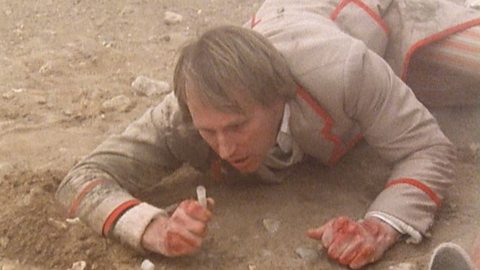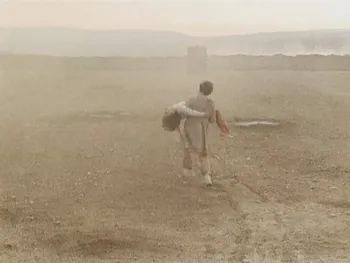The Caves of Androzani
"Mud. Mud. Glorious mud."
Episodes: The Caves of Androzani Parts Two and Four
Seen: 9th & 16th March 1984
The Long Way Round
The Caves of Androzani has been declared the greatest Doctor Who story ever told on multiple occasions. That presents us, well, me with a problem. In that it is sometimes harder to write, even to think, about great Doctor Who than it is lesser Doctor Who. Often great Doctor Who feels like it’s been “done”. What is there to say about a story where pretty much everything went exactly right?
To praise Graeme Harper’s direction for how it seems to rewrite the book on what’s possible on low budget studio VT is simply to repeat generations of fan responses. To say the appearance of the Magma Beast is the serial’s only low point is make a statement without a purpose. To talk of the astounding cliffhanger to Part Three invites nods of agreement but wins no converts to a cause.
To argue over whether Morgus’ to-camera deliveries are deliberately scripted or an on-camera misunderstanding that became a brilliant piece of improvisation, is to fight over a distinction without a meaningful difference. To wonder why the Doctor doesn’t drink the bat’s milk before trying to get Peri back to the TARDIS is simply to miss the bloody point entirely.
What to say then about The Caves of Androzani? That Rober Holmes’ scripts were commissioned and completed without fuss? That script editor Eric Saward was delighted with, and did little work on, them? That Holmes original title, Chain Reaction is also a description of how the script works? Everything following logically, inevitably, step by step, from the moment the Doctor arrives to the moment he, well, dies? Peter Davison was pleased that this was his final story. It remains his favourite, and it was so good that it made him sort of wish he was staying. Except of course it wouldn’t have been as good a story if he had been. But again, you all know that. You’ve all known that for a long time.
It is even more than three decades since Paul Cornell1 put forward the once controversial, and now rightly largely accepted, thesis that Androzani’s greatness had a detrimental effect on Doctor Who as an ongoing series.2 That this happened because Saward attempted to replicate its success by the two simple method of duplicating some of its many elements, but he then went about deploying them far less effectively. Although it is a measure of the story’s own greatness that while Saward dulled these elements effectiveness by overuse, that has had no retrospective impact on Androzani when viewing it. Like the great films repeatedly plundered by golden age The Simpsons to act as punchlines, it retains its own power.
Personally, I’ve always thought that more should be made of Robert Glenister’s performances as both Major Salateen and his android duplicate. Most of Doctor Who’s dual roles involve “good” and “bad” versions of a character. But not Salateen. The “real” Salateen is, while a dedicated officer, quick to violence, morbid and rather cruel. His android duplicate is murderous, unctuous and preternaturally calm, but is also probably better company.
Glenister, then best known for starring opposite Davison in Sink or Swim (1980-82), separates his two characters with fascinating performance details. Salateen flicks his hair and licks his dry lips, human impulses his duplicate has no use for. The android slowly turns to address people, while Salateen’s eyes flick nervously around any room, evidence of a man living under extreme stress for far too long.
That’s newish, isn’t it? Except I got to say most of it myself in Doctor Who Magazine last year. Boo.
I might add to it, then, by pointing out that, yes, the death of the real Salateen so shocking because it comes out of the blue, and that this prompted Saward to include it amongst the things he repeatedly borrowed from the story, but it is effective in the way none of those borrowings are, because his double appears in the rest of the story, in the process becoming almost literally the walking dead.
More, when the Android Salateen holds his master Sharez Jek’s body as he dies, he inadvertently creates the image of an action with more compassion, more humanity, than the anything the real Salateen has done in the story. An image not that far from that of the Doctor carrying a comatose Peri over the sand dunes to safety even though it will result in his own death.
Both, it seems to me, invoke Michelangelo’s Pietà, a statue of Mary cradling the dead Jesus after he has been taken down from the cross; an image also constantly referenced in the medium of American superhero comics.3
If I close my eyes and try, I can still feel the room in which I saw The Caves of Androzani Part Four. The carpet under my crossed legs. The heat from the radiator to my right. The deep, wide wooden television which was literally inherited from my grandmother when she’d died the previous year. The crashing, rattling music as the Doctor went over a sand dune chased by an angry Scotsman with a machine gun, and that bloke from Sorry! Then more of the same twenty minutes later, as the Doctor staggered back over the landscape carrying a surely dead Peri, pursued by boiling mud.

This is the point where I became absolutely determined to see Doctor Who, rather than it being one of the things I watched, and by “this” I mean the picture above the paragraph you’re reading. More or less to the frame. Now, it didn’t work out like that. In fact, I missed the very next episode. Because I was six and didn’t have that much say in what I did. Plus I suspect the Smith household of 1984 still wasn’t quite capable of parsing the idea of the programme being on twice a week, but this is, if you like, when this particular Doctor Who fan heard the call.
The first entry in this series was about how Logopolis Part Four was when I first became aware of Doctor Who. Is it coincidental that The Caves of Androzani, exactly one whole Doctor later was when that awareness hardened into a kind of commitment? I don’t know.
I do know that the ability to replace the series’ lead actor, and then set off in a new creative direction, is key to Doctor Who’s longevity. It’s one of the reasons it can be, has been, always will be, revived if it ever goes away. It’s also incredibly powerful in pure dramatic terms. Death, and then unexpected resurrection. The purity of self-sacrifice for the innocent in a world of avarice and betrayal has enormous cultural weight, and Androzani draws from that without reluctance or irony to offer its own greatest story ever told.
This is where I came in.

Hi Paul!
The Androzani Effect, dwb #29 / 30 Christmas 1985.
E.g the cover to Crisis on Infinite Earths #7 (1985), and a key scene in Batman: A Death in the Family (1988)